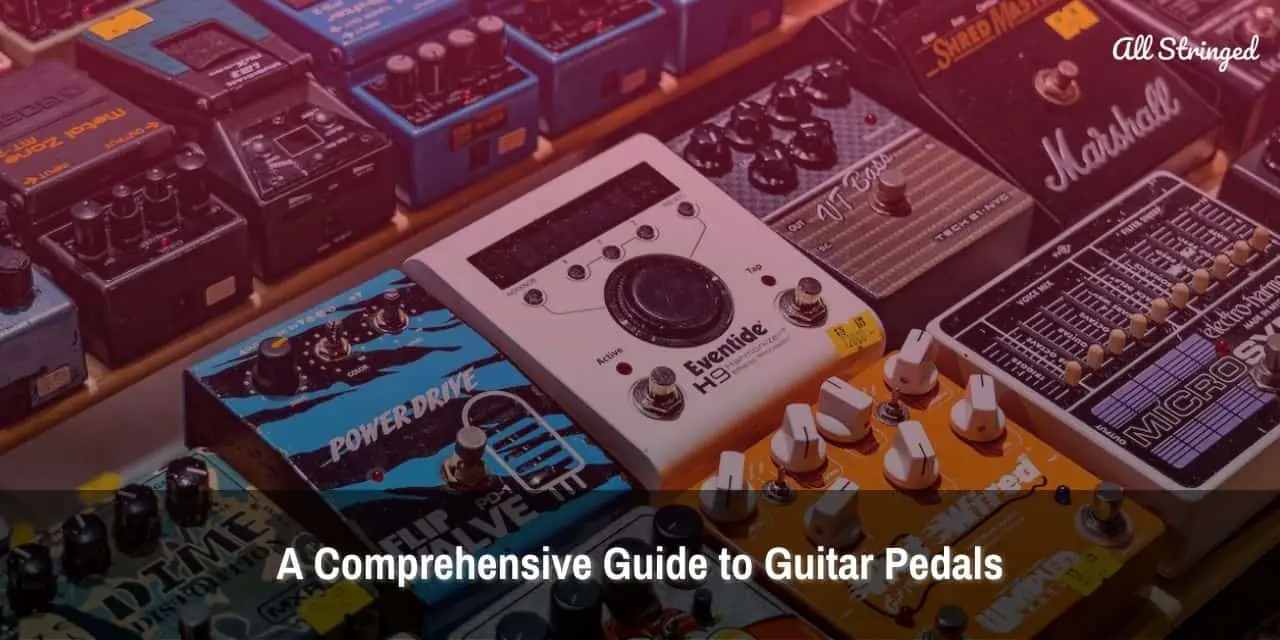Welcome to “Unleash Your Sonic Potential: A Comprehensive Guide to Guitar Pedals.” If you’ve ever marveled at the diverse and captivating tones produced by your favorite guitarists, you can bet that a significant part of their secret lies in the realm of guitar pedals. These magical devices have the power to shape and transform your guitar’s sound, taking it from ordinary to extraordinary.
In this guide, we’ll embark on a journey through the captivating world of guitar pedals, exploring their immense importance in crafting your unique sonic identity. We’ll delve into the intricate workings of various pedal types, unravel their distinctive features, and uncover the genres and musical styles that benefit most from their use.
But be warned: once you embark on this voyage, you may find yourself captivated by the endless possibilities and inspired to create music that pushes the boundaries of your imagination. So, let’s dive in and unlock the mysteries of guitar pedals together.
I. Introduction to Guitar Pedals
Shaping Your Sonic Landscape: Discover the profound influence of guitar pedals on crafting your desired tone.
In the world of music, the guitar has long been revered for its ability to captivate and express a wide range of emotions. But what if we told you that the true magic lies not only in the instrument itself but also in the wondrous realm of guitar pedals? These unassuming boxes hold the power to shape and transform your guitar’s sound, taking it from ordinary to extraordinary.
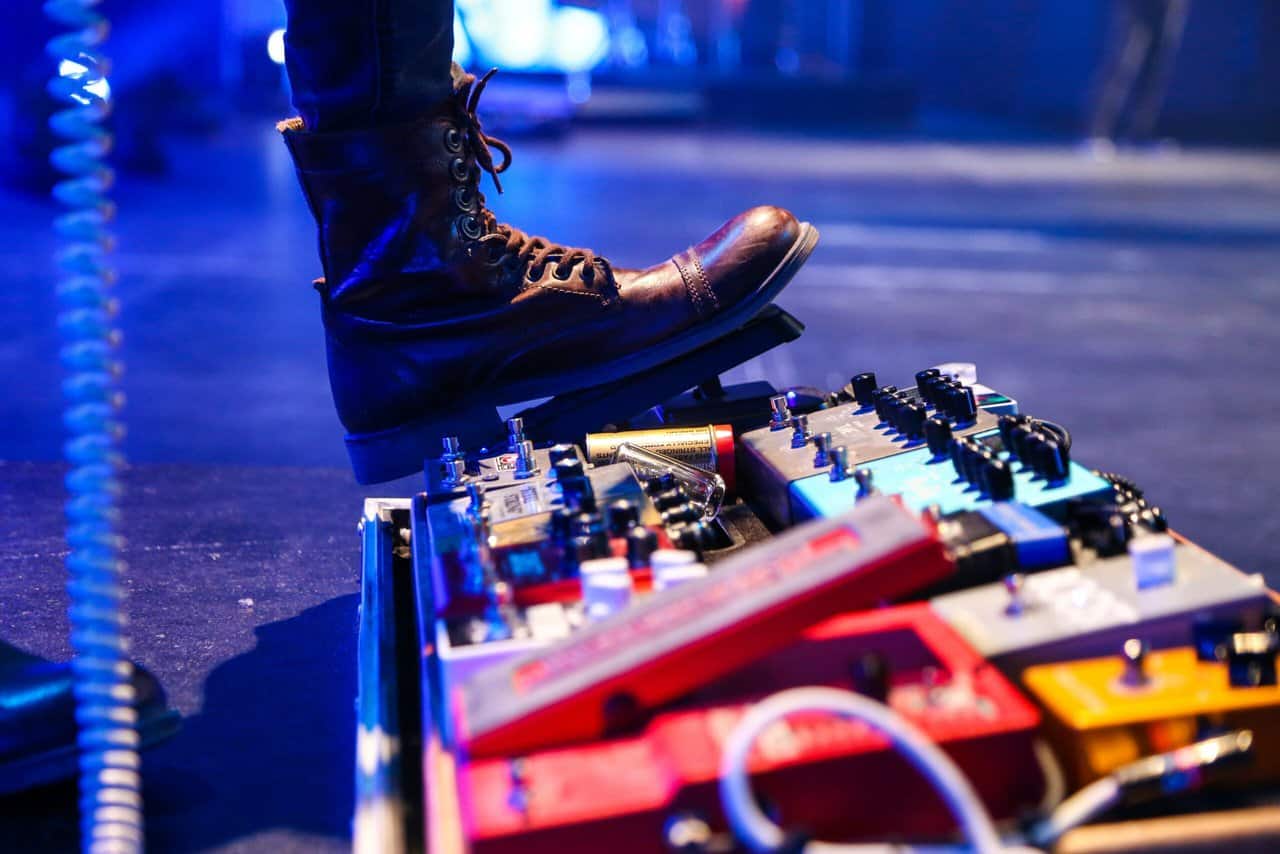
Guitar pedals are like a painter’s palette, offering an array of colors and textures to create your sonic masterpiece. Whether you desire searing distortion, soulful overdrive, ethereal modulation, or pristine clarity, there’s a pedal out there ready to help you achieve your sonic aspirations.
Signal Chain Secrets: Gain insights into how guitar pedals interact within the signal chain setup and their role in sculpting your sound.
To understand the impact of guitar pedals, it’s crucial to grasp their place within the signal chain setup. Think of the signal chain as a series of building blocks, with each pedal contributing its unique flavor to the overall tone.
Typically, the signal chain begins with your guitar, which feeds into the first pedal in line. From there, the signal flows through a series of effects, with each subsequent pedal altering the sound in its own distinctive way. The order of the pedals can drastically change the outcome, allowing for endless possibilities in tone shaping.
By experimenting with different pedal arrangements, you can unlock new sonic dimensions and discover your own personal holy grail of tone. Whether you prefer a classic approach with distortion or opt for a more intricate setup with modulation and time-based effects, the signal chain is your playground for sonic exploration.
Sonic Alchemy: Embrace the adventurous spirit of experimentation with different pedals to unearth your signature sound.
In the realm of guitar pedals, sonic alchemy is the key to unlocking your signature sound. Each pedal is like a unique ingredient in a musical recipe, allowing you to sculpt and shape your tone to match your artistic vision.
Embrace the adventurous spirit of experimentation as you dive into the world of guitar pedals. Try different combinations, tweak knobs, and let your ears guide you. Sometimes the unexpected can lead to the most remarkable discoveries.
Remember, the journey to finding your signature sound is a personal one. Your favorite guitarists didn’t settle for the status quo; they dared to push boundaries and create something entirely their own. So, grab your guitar, plug in those pedals, and embark on a sonic adventure that will unveil a world of endless possibilities.
In the following sections, we will explore the most common types of guitar pedals, delving into their definitions, purposes, key features, and the genres that they excel in. Get ready to unlock the secrets of distortion, overdrive, modulation, dynamics control, and more. Your sonic destiny awaits!
II. Common Types of Guitar Pedals
A. Distortion Pedal
The Roar of Distortion: Uncover the definition and purpose of a distortion pedal, and how it injects raw power and aggression into your guitar tone.
>>> Click here to find the best distortion pedals <<<
At the heart of rock and heavy metal lies the mighty distortion pedal. This pedal is designed to take your guitar signal and push it to its limits, resulting in a rich, harmonically saturated tone that exudes aggression and intensity. By introducing clipping and gain stages into the signal chain, distortion pedals shape your sound with a roaring, driven edge.
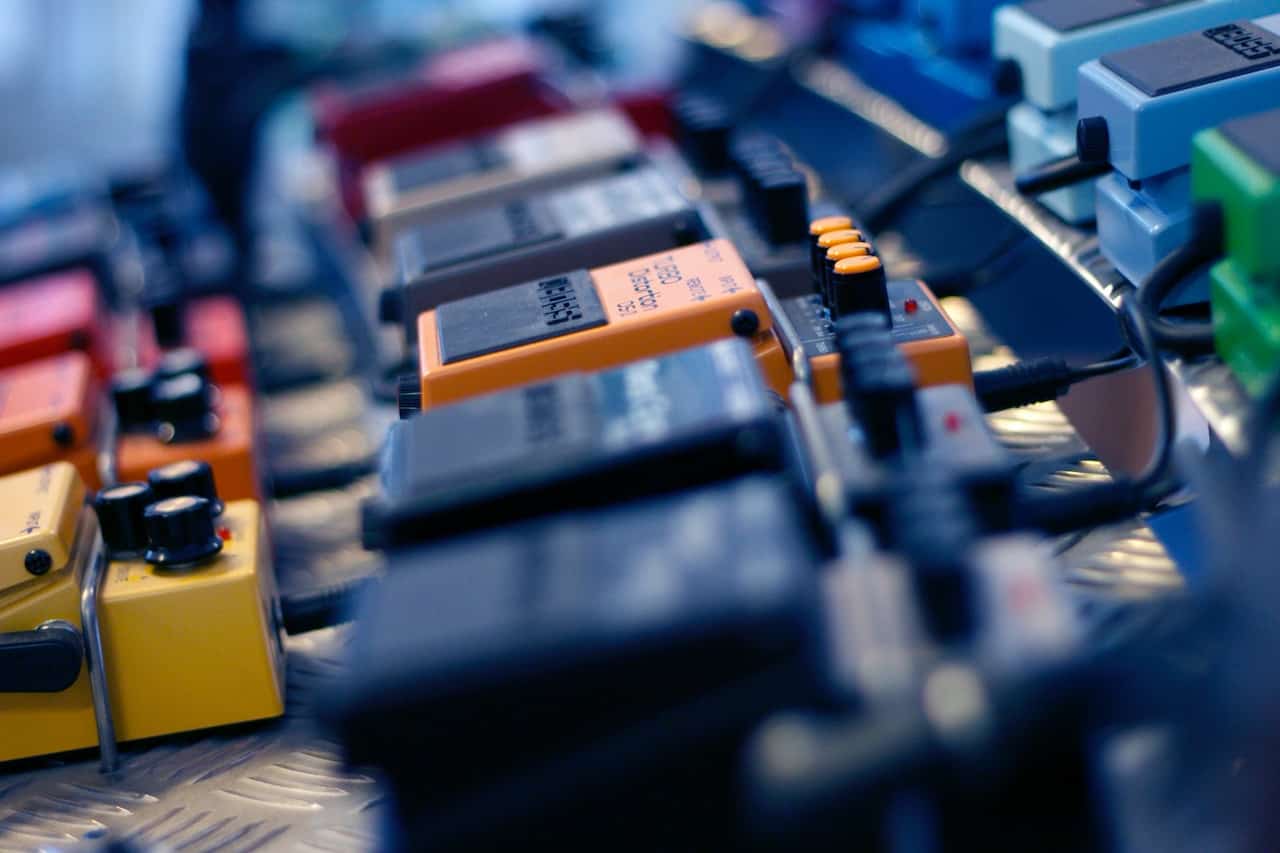
Key Tools of Sonic Rebellion: Explore popular distortion pedal models and their unique features that shape your sound.
From classic options like the Boss DS-1 to the iconic Pro Co Rat, the world of distortion pedals offers a vast array of choices. Each model brings its own tonal characteristics, ranging from tight and focused to thick and heavy. Some distortion pedals provide additional controls, such as tone shaping, gain staging, or even built-in EQ options, allowing you to fine-tune your tone to perfection.
Tonal Palette: Delve into the effects of distortion pedals on different musical styles, from blistering rock to searing metal.
Distortion pedals are the lifeblood of genres like hard rock, punk, and metal. They provide the searing, high-gain tones that define these styles. However, don’t be fooled into thinking distortion is limited to these genres alone. Distortion pedals can also add an edge to blues, indie, and alternative styles, offering a dynamic range of tonal options that suit various musical expressions.
B. Overdrive Pedal
The Soulful Drive: Discover the definition and purpose of an overdrive pedal, and how it imparts warmth and harmonics to your guitar sound.
>>> Click here to find the best overdrive pedals <<<
If you’re seeking a smoother, more vintage-inspired tone, look no further than the beloved overdrive pedal. Designed to simulate the natural breakup and tube saturation of vintage amplifiers, overdrive pedals add warmth, dynamics, and a touch of grit to your guitar tone. They excel at producing smooth, singing sustain and responsive touch sensitivity.
Gear Up for Overdrive: Explore key features and popular models that lend character and versatility to your playing.
Whether you’re drawn to the legendary Tube Screamer or the versatile Fulltone OCD, the overdrive pedal market offers a wealth of options. Each model brings its own sonic characteristics, allowing you to find the perfect balance of gain, tone, and responsiveness. Many overdrive pedals provide control over gain levels, tone shaping, and even additional features like boost functions or multiple voicings.
Distortion vs. Overdrive: Uncover the distinctions between these two beloved effects and the musical genres that thrive on overdrive pedals.
While both distortion and overdrive pedals provide gain and saturation, they offer different flavors of drive. Overdrive pedals tend to be more transparent, retaining the nuances of your playing and the natural tone of your guitar. They are favored in blues, country, and classic rock genres. Distortion pedals, on the other hand, deliver a more aggressive and heavily saturated tone, making them a staple in hard rock, metal, and heavier music styles.
C. Phaser Pedal
Enter the Swirling Abyss: Unleash the definition and purpose of a phaser pedal, as it engulfs your sound with captivating swirling and sweeping effects.
>>> Click here to find the best phaser pedals <<<
Prepare to embark on a cosmic journey with the mesmerizing phaser pedal. This unique effect splits your guitar signal into two or more paths, modulating the phase relationship between them to create swirling, undulating sonic landscapes. The result is a captivating, swirling abyss of sound that adds depth and movement to your playing.
Embark on Sonic Adventures: Discover popular phaser pedal models and their unique features, taking your sound on cosmic journeys.
Fromclassic options like the MXR Phase 90 to more experimental choices like the Electro-Harmonix Small Stone, phaser pedals offer a range of tonal possibilities. Some models provide control over the speed, depth, and resonance of the modulation, allowing you to sculpt the intensity and character of the phasing effect. Whether you crave subtle, shimmering textures or mind-bending, psychedelic swirls, there’s a phaser pedal to match your sonic desires.
Immortalized in Sound: Explore famous songs that prominently feature the captivating soundscapes of phaser pedals.
Phaser pedals have left their mark on countless iconic songs across various genres. From Eddie Van Halen‘s unmistakable phaser-drenched solos in “Ain’t Talkin’ ‘Bout Love” to David Gilmour’s ethereal phaser tones in Pink Floyd’s “Shine On You Crazy Diamond,” the swirling, sweeping soundscapes of phaser pedals have shaped the sonic landscapes of countless musical masterpieces. So, plug in your phaser pedal and let your playing soar through the astral plane of sonic exploration.
D. Noise Gate Pedal
Silence the Unwanted: Embrace the definition and purpose of a noise gate pedal, and how it eradicates unwanted noise and hum.
>>> Click here to find the best noise gate pedals <<<
In the pursuit of pristine tone, every guitarist encounters the frustrating buzz, hiss, and hum that can plague their signal. Enter the noise gate pedal, a powerful tool designed to suppress unwanted noise when you’re not playing. By setting a threshold, the noise gate pedal acts as a gatekeeper, allowing your desired notes to pass through while clamping down on background noise, ensuring a clean and focused sound.
Key Features for Serenity: Explore popular noise gate pedal models and their essential features that restore pristine clarity to your playing.
From classic offerings like the Boss NS-2 Noise Suppressor to advanced noise gate pedals like the ISP Technologies Decimator II, noise gate pedals come in a variety of shapes and sizes. Some models offer adjustable attack and release controls, allowing you to fine-tune the pedal’s response to match your playing style. Additionally, features like loop integration and multi-band noise reduction provide even greater control over noise suppression, enabling you to tailor the pedal to your specific needs.
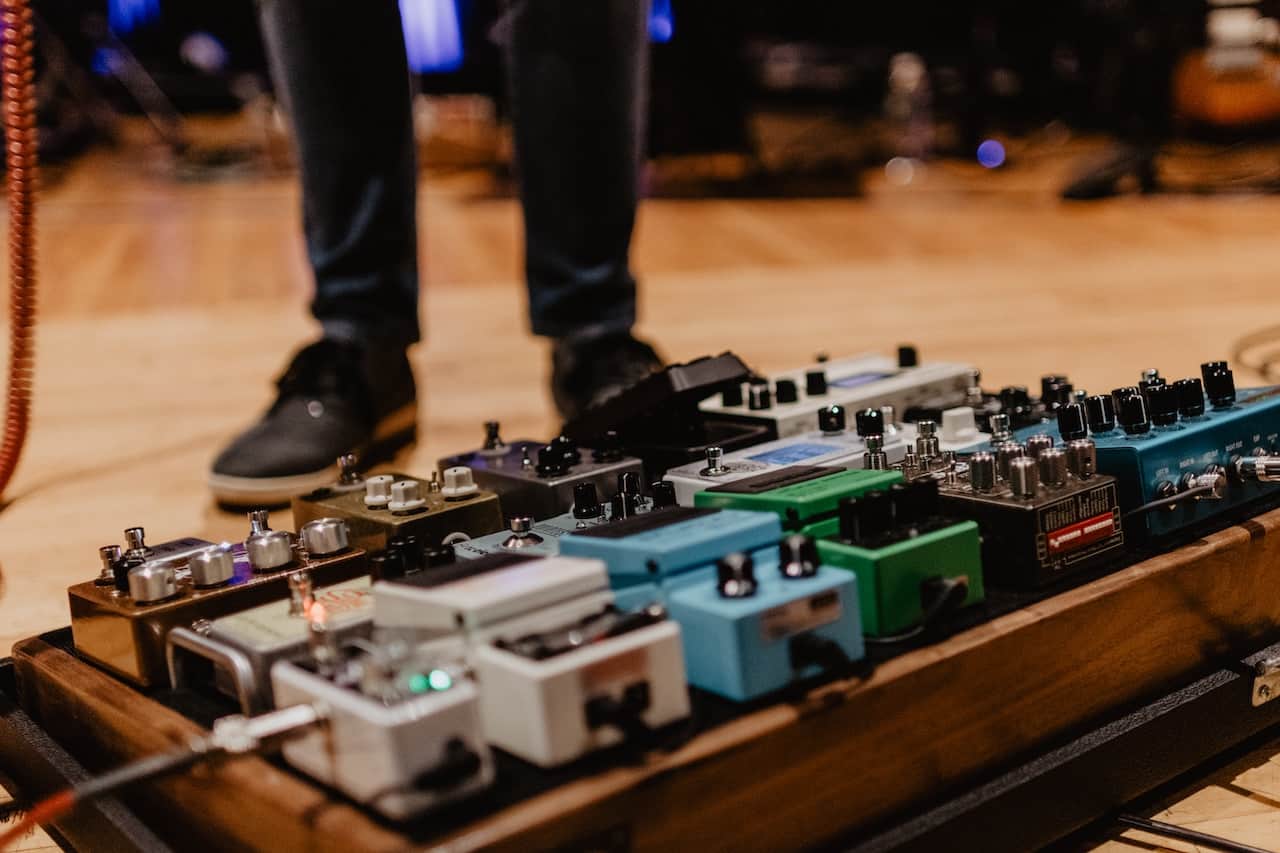
Mastering High-Gain Realms: Uncover the application of noise gate pedals in high-gain and metal genres, taming the chaos while preserving your precision.
High-gain and metal guitarists rely heavily on noise gate pedals to tame the inherent noise associated with aggressive distortion and high volume levels. By eliminating unwanted noise between palm-muted chugs, razor-sharp riffing, and blistering solos, noise gate pedals ensure that each note rings out with clarity and precision. They allow for tight, articulate playing, even in the most extreme sonic landscapes.
E. Pedalboard
Command Center of Tones: Discover the definition and purpose of a pedalboard, serving as the foundation for your sonic arsenal.
>>> Click here to find the best pedalboard <<<
A pedalboard is the beating heart of your guitar rig, providing a centralized platform to house and organize your collection of guitar pedals. It serves as a command center, ensuring quick and easy access to your desired tones during live performances or studio sessions.
The Perfect Fit: Explore different types of pedalboards, from traditional to powered and modular setups, to find the one that suits your needs.
Pedalboards come in various shapes, sizes, and configurations. Traditional pedalboards feature a sturdy board or case with Velcro or pedal-specific attachments to secure your pedals. Powered pedalboards offer built-in power supplies and cable management systems, streamlining your setup and eliminating the need for individual power adapters. Modular pedalboards provide customizable options, allowing you to rearrange and expand your board as your pedal collection evolves.
Organization and Cable Wizardry: Learn the importance of keeping your pedalboard tidy, optimized, and ready for sonic exploration.
Effective cable management is crucial to maintaining a clean and reliable signal path on your pedalboard. Properly routing and organizing cables minimizes unwanted noise, interference, and signal loss. Implementing strategies such as using high-quality cables, utilizing cable ties or Velcro straps, and planning efficient signal flow ensures your pedalboard remains organized, efficient, and free from cable clutter.
Crafting Your Sonic Arsenal: Gather tips for building and arranging your pedalboard setup, ensuring a seamless and efficient experience.
Building a pedalboard is an opportunity to create a personalized sonic arsenal tailored to your musical preferences. Consider factors like the order of your pedals in the signal chain, the placement of essential pedals within easy reach, and any specific needs for power supply or switching systems. With careful thought and planning, you can construct a pedalboard that empowers your creativity and unleashes your sonic potential.
F. Looper Pedal
The Infinite Soundscape: Embrace the definition and purpose of a looper pedal, enabling you to layer guitar parts and expand your creative possibilities.
>>> Click here to find the best looper pedals <<<
A looper pedal is a powerful tool that allows you to record and playback loops of your own guitar playing. It provides the ability to layer multiple guitar parts in real-time, essentially turning you into a one-person band. With a looper pedal, you can create complex compositions, build lush sonic landscapes, practice scales and improvisation, or simply indulge in the joy of playing along with your own recorded accompaniment.
Unveiling Looping Legends: Discover popular looper pedal models that unlock the potential for mesmerizing performances and immersive practice sessions.
Looper pedals come in various shapes and sizes, offering different features and capabilities to suit different musical needs. From the simple yet effective TC Electronic Ditto Looper to the versatile and feature-rich Boss RC-300 Loop Station, there’s a looper pedal out there to match your creative vision. Explore the options available and choose a looper pedal that aligns with your desired functionality and ease of use.
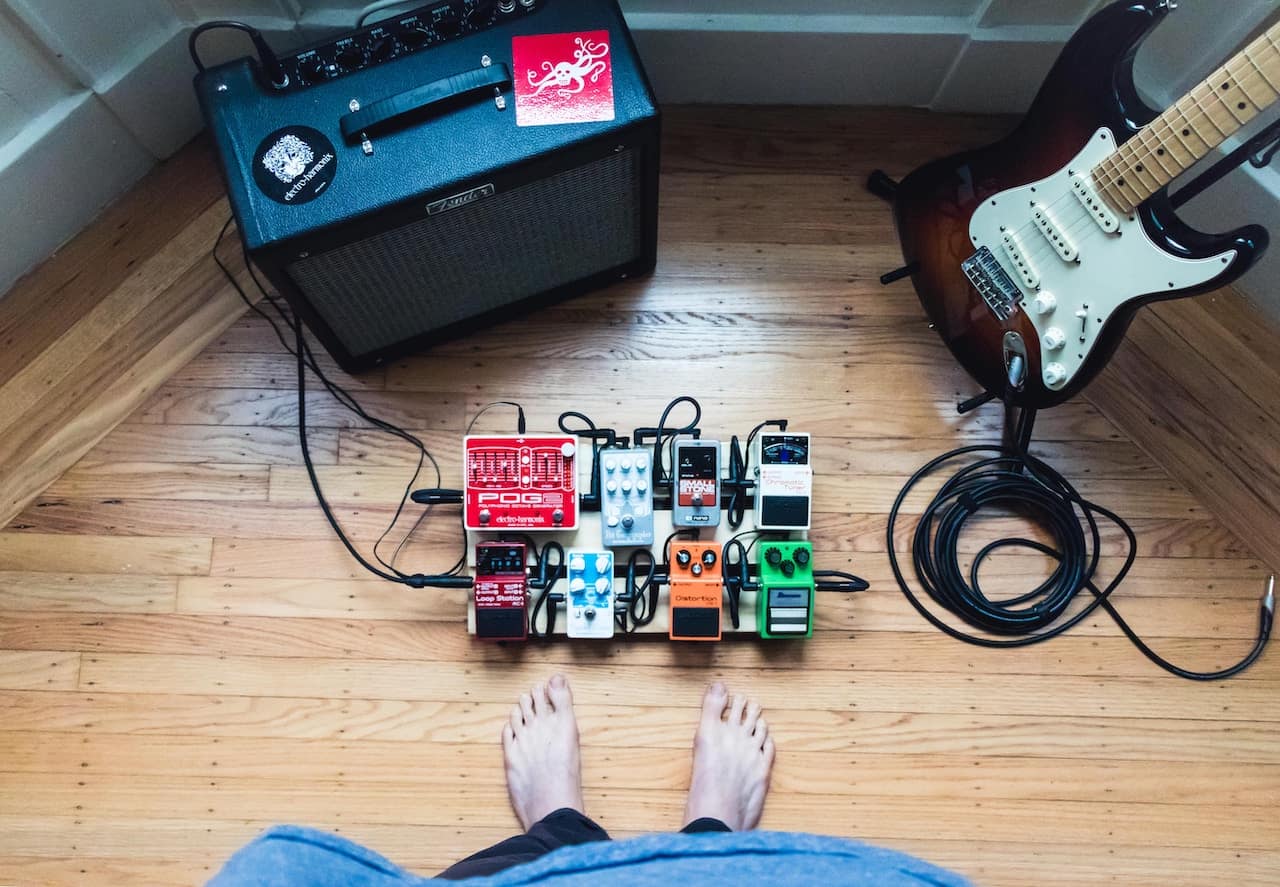
Weaving Musical Tapestries: Learn from notable guitarists known for their innovative use of looper pedals, creating sonic masterpieces through live looping.
Many visionary guitarists have harnessed the power of looper pedals to create captivating performances and push the boundaries of what’s possible with a single instrument. Artists like Ed Sheeran, KT Tunstall, and Andrew Bird have showcased their mastery of live looping, using it as a foundation for their unique musical expressions. Take inspiration from these trailblazers and explore the boundless creative potential of a looper pedal.
G. Chorus Pedal
Shimmering Harmonic Waves: Immerse yourself in the definition and purpose of a chorus pedal, as it adds depth and richness to your guitar tone.
>>> Click here to find the best chorus pedals <<<
The chorus pedal is a classic modulation effect that enriches your guitar sound with lush, shimmering harmonics. It works by duplicating the incoming signal, slightly altering the pitch of one of the signals, and then mixing the two together. This creates the illusion of multiple guitars playing in unison, resulting in a beautifully rich and textured sound.
Captivating Modulation: Explore popular chorus pedal models and their distinctive features, allowing you to create lush, dreamlike textures.
From the iconic Boss CE-2 Chorus to the versatile Strymon Mobius, chorus pedals come in various flavors. Some models provide control over parameters such as depth, speed, and tone, enabling you to shape the intensity and character of the chorus effect. Whether you’re aiming for subtle, watery textures or ethereal, wide soundscapes, the right chorus pedal will add a captivating dimension to your playing.
Genres Adorned with Chorus: Uncover the musical genres where chorus pedals are most commonly used, contributing to their signature atmospheres.
Chorus pedals have left an indelible mark on a range of musical genres. They are a staple in genres like ’80s pop, where they helped define the signature guitar sounds of that era. Additionally, chorus pedals find their place in genres like shoegaze, post-rock, and alternative rock, adding a dreamy, atmospheric quality to the music. Experiment with a chorus pedal to infuse your playing with the shimmering beauty that has enchanted generations of music lovers.
H. Compressor Pedal
Dynamics Under Control: Understand the definition and purpose of a compressor pedal, as it enhances sustain and evens out your playing dynamics.
>>> Click here to find the best compressor pedals <<<
A compressor pedal is a tool used to control the dynamics of your guitar signal. It works by reducing the dynamic range of your playing, bringing softer notes up in volume while limiting the volume of louder notes. This evens out the overall volume and increases sustain, resulting in a more consistent and polished sound.
The Art of Dynamics: Explore key features and popular compressor pedal models that shape your tone and add clarity to your guitar playing.
Compressor pedals come in a variety of designs, each offering its own set of features and sonic characteristics. From the renowned Keeley Compressor Plus to the versatile MXR Dyna Comp, these pedals provide control over parameters such as threshold, ratio, attack, and release, allowing you to dial in the desired amount of compression and shape your tone with precision. Whether you seek subtle dynamic control or pronounced squash and sustain, a compressor pedal is a valuable tool to consider.
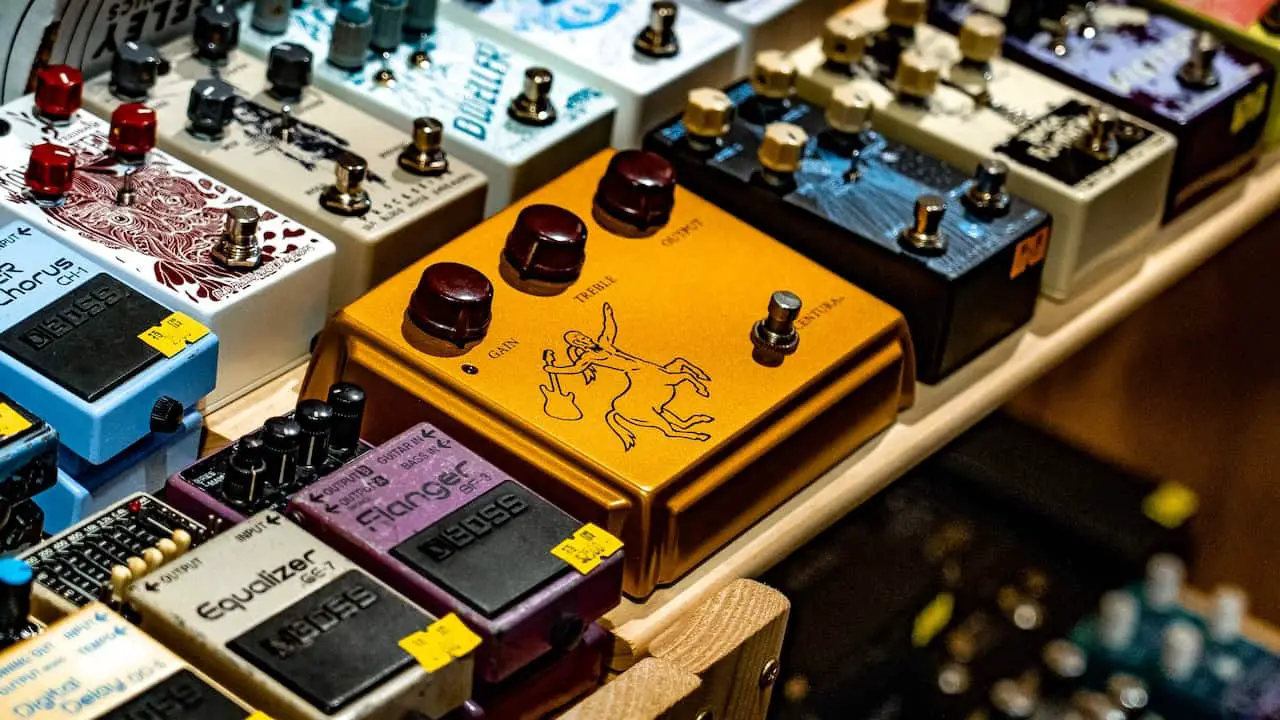
Sustaining Excellence: Discover the benefits of using a compressor pedal, from accentuating delicate nuances to achieving controlled sustain.
A compressor pedal can enhance your playing in numerous ways. It can bring out the nuances of softer passages, adding clarity and definition to your notes. It also assists in achieving controlled sustain, allowing your guitar to sing and ring out beautifully. Whether you’re engaging in intricate fingerpicking or unleashing blistering solos, a compressor pedal can elevate your playing by providing a consistent and polished tone.
I. Octave Pedal
Shaping the Sound Spectrum: Embrace the definition and purpose of an octave pedal, as it transforms your guitar notes into powerful octave-up or octave-down effects.
>>> Click here to find the best octave pedals <<<
An octave pedal takes your guitar signal and generates a new note that is either one octave higher or one octave lower than the original pitch. This transformation allows you to explore a wider tonal spectrum and create unique sonic textures. Whether you want to add depth and richness with an octave-down effect or bring a touch of brightness and harmonic complexity with an octave-up effect, an octave pedal opens up a world of creative possibilities.
Key Features for Sonic Shapeshifting: Explore popular octave pedal models and their unique characteristics, expanding the tonal possibilities of your playing.
Octave pedals come in various shapes and sizes, offering different features and tracking capabilities. From the legendary Electro-Harmonix POG (Polyphonic Octave Generator) to the versatile TC Electronic Sub ‘N’ Up Octaver, these pedals allow you to dial in the desired amount of octave effect and tailor it to your playing style. Some models offer additional controls such as blend, tone shaping, and multiple octave options, empowering you to sculpt the perfect octave sound.
Songs of Octave Exploration: Unveil notable songs that showcase the creative usage of octave pedals, pushing the boundaries of sonic expression.
Octave pedals have left an indelible mark on many iconic songs, pushing the boundaries of sonic exploration. From Jimi Hendrix’s legendary use of octave effects in “Purple Haze” to Tom Morello’s distinctive octave-driven riffs in Rage Against the Machine’s “Killing in the Name,” these pedals have become essential tools for adding unique character and depth to guitar playing. Dive into the world of octave effects and be inspired by the limitless sonic possibilities that await you.
J. Vibrato Pedal
Modulating the Melody: Dive into the definition and purpose of a vibrato pedal, adding modulation and pitch variation to your guitar notes.
>>> Click here to find the best vibrato pedals <<<
A vibrato pedal introduces modulation and pitch variation to your guitar signal, creating a wobbling or pulsating effect that mimics the natural vibrato produced by a guitarist’s fingers. It adds depth, expressiveness, and a touch of vintage charm to your playing. With a vibrato pedal, you can infuse your guitar notes with subtle or pronounced pitch fluctuations, adding a unique flavor to your melodies and solos.
Key Features for Expressive Playing: Explore popular vibrato pedal models and their essential features, enabling you to infuse your playing with evocative vibrato.
Vibrato pedals come in various designs, offering different controls and sonic characteristics. From the classic designs like the Boss VB-2 Vibrato to modern offerings like the Strymon Flint, these pedals provide adjustable depth, speed, and waveform controls, allowing you to shape the intensity and character of the vibrato effect. Some models even offer additional features such as tap tempo and stereo outputs, further expanding your sonic options.
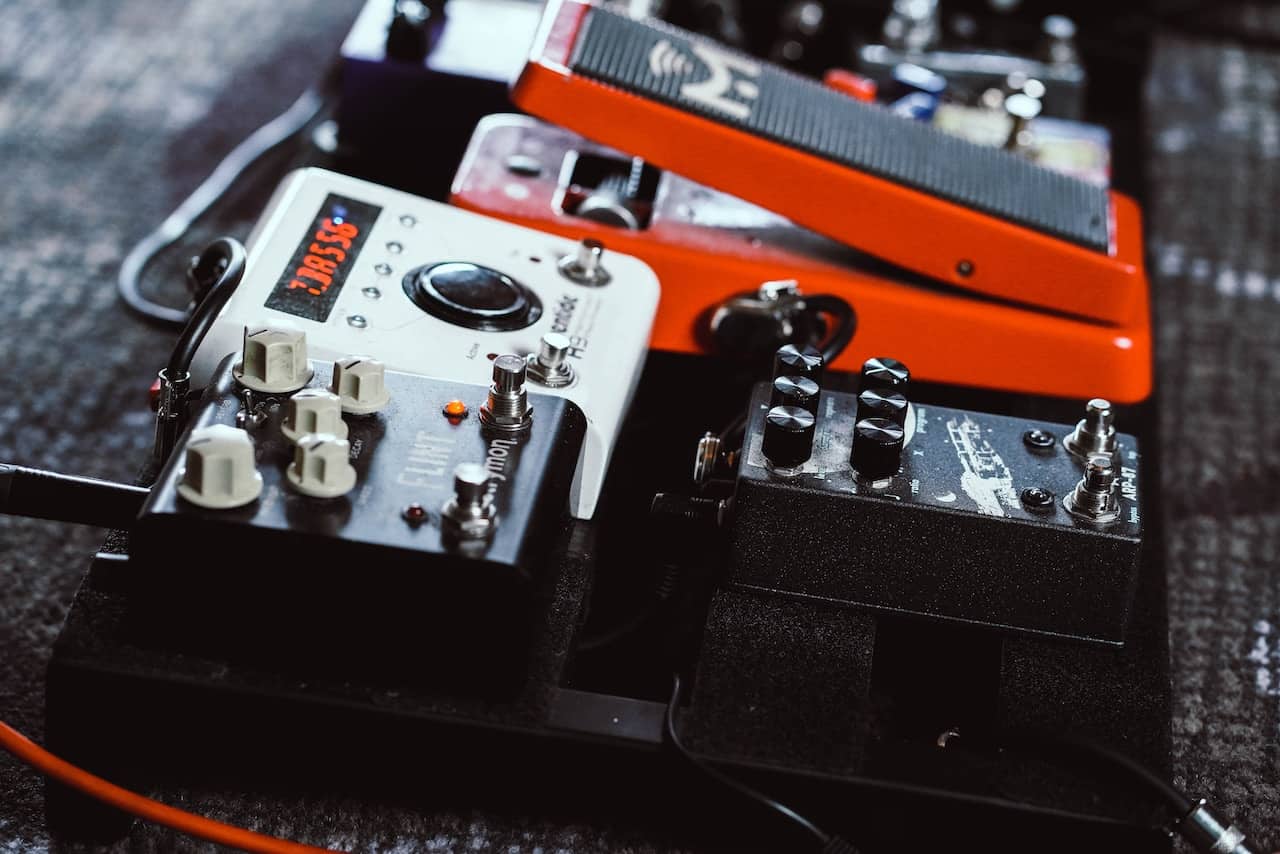
Expressions of Vibrato: Discover the application of vibrato pedals in blues, rockabilly, and psychedelic music, elevating your playing with vintage charm and psychedelic swirls.
Vibrato pedals have long been associated with genres like blues, rockabilly, and psychedelic rock, where their distinctive modulation adds a touch of nostalgia and character. From the sultry bends of blues legends like Stevie Ray Vaughan to the twangy, country-infused licks of rockabilly pioneers like Brian Setzer, the vibrato effect has played a pivotal role in shaping the sound and feel of these genres. Embrace the vibrato pedal and let your playing sway with expressive and evocative vintage charm.
III. Conclusion
Throughout this exploration of guitar pedals, we have witnessed the remarkable impact these small but mighty devices have on sculpting your guitar tone. From distortion and overdrive pedals that inject raw power and warmth, to modulation pedals that add depth and movement, each type of pedal offers a unique sonic signature. By harnessing the power of guitar pedals, you have the ability to unleash your sonic potential and craft a tone that truly represents your musical vision.
As we conclude this journey through the world of guitar pedals, we implore you to embark on your own path of sonic exploration. While we have covered the common types of guitar pedals, there are many more out there waiting to be discovered. Dare to go beyond the familiar and venture into uncharted sonic territories. Experiment with different pedal combinations, push the limits of your creativity, and be open to unexpected sonic possibilities. It is through this spirit of exploration that you will truly find your unique voice as a guitarist.
Our exploration of guitar pedals has only scratched the surface of their immense capabilities. To delve deeper into each pedal type, we invite you to visit the individual subpages dedicated to distortion, overdrive, phaser, noise gate, pedalboard, looper, chorus, compressor, octave, and vibrato pedals. There, you will find more detailed information, insights into popular models, tips for using each pedal effectively, and even inspiration from renowned guitarists who have harnessed the power of these pedals to shape their unique sound.
So, continue your journey, fellow guitarist, armed with the knowledge and inspiration you have gained. Embrace the sonic alchemy of guitar pedals, push the boundaries of your creativity, and let your playing soar to new heights. Your sonic destiny awaits, and the world of guitar pedals is ready to elevate your music to extraordinary realms.
Are you interested in Guitar Gear? Read our in-depth guitar gear guide here: 10 Must-Have Guitar Gear Every Guitarist Needs

